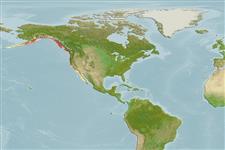Polyplacophora |
Chitonida |
Mopaliidae
Environment: milieu / climate zone / εύρος βάθους / distribution range
Οικολογία
; εύρος βάθους 0 - 40 m (Αναφ. 290). Temperate
Eastern Pacific.
Length at first maturity / Μέγεθος / Weight / Age
Γεννητική Ωρίμανση: Lm ? range ? - ? cm Max length : 13.0 cm TL αρσενικό/απροσδιόριστο; (Αναφ. 290)
Girdle: Black leathery covering almost the entire dorsal area. Dorsal ridge area of each valve: small portion; left exposed (Ref. 296).
Surf-zone to 40 m. Usually found on stony or rocky bottoms (Ref. 290); in the middle intertidal zone from Alaska to Point Conception; North of Santa Barbara; also on rocky shore with heavy wave action (Ref. 312). Herbivorous, feeding primarily on red and green algae and benthic diatoms (Ref. 312).
Life cycle and mating behavior
Γεννητική Ωρίμανση | Αναπαραγωγή | Γεννοβολία | Eggs | Γονιμότητα | Larvae
Members of the class Polyplacophora are mostly gonochoric. Life cycle: Eggs hatch into lecitotrophic planktonic trocophore larvae (no veliger stage) which later metamorphose and settle on the bottom as young adults.
Burghardt, G. and L. Burghardt 2006 West Coast Chitons. A Gallery of Worlwide Chitons: http://home.inreach.com/burghart/wcoast.html[accessed20/01/06] (Αναφ. 296)
IUCN Red List Status
(Αναφ. 130435: Version 2025-1)
CITES status (Αναφ. 108899)
Not Evaluated
Not Evaluated
Threat to humans
Human uses
| FishSource |
Εργαλεία
Περισσότερες πληροφορίες
Population dynamicsΑύξηση
Max. ages / sizes
Length-weight rel.
Length-length rel.
Length-frequencies
Mass conversion
Αφθονία
Life cycleΑναπαραγωγήΓεννητική ΩρίμανσηΓονιμότηταΓεννοβολίαEggsEgg developmentLarvae PhysiologyΚατανάλωση οξυγόνου
Human RelatedStamps, coins, misc.
Διαδικτυακές πηγές
Estimates based on models
Preferred temperature
(Ref.
115969): 6.1 - 10.9, mean 8.9 (based on 94 cells).
Fishing Vulnerability
Low vulnerability (10 of 100).
Price category
Unknown.
